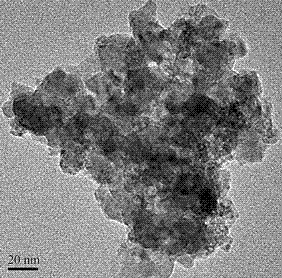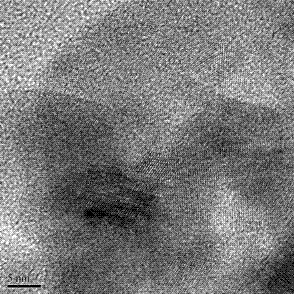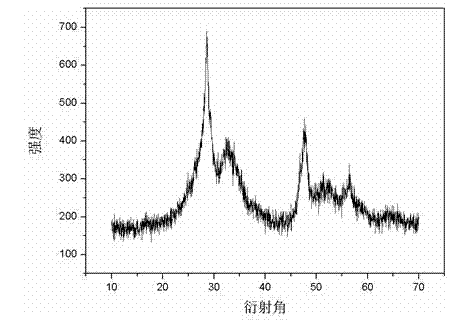Preparation method of copper zinc tin sulfide/graphene oxide composite semiconductor photocatalyst
A graphene composite, copper-zinc-tin-sulfur technology, applied in the direction of physical/chemical process catalysts, chemical instruments and methods, chemical/physical processes, etc., can solve the problem of catalytic activity decline and achieve improved resistance to photodissolution and photocorrosion effect of ability
- Summary
- Abstract
- Description
- Claims
- Application Information
AI Technical Summary
Problems solved by technology
Method used
Image
Examples
Embodiment 1
[0030] A preparation method of a copper-zinc-tin-sulfur compound includes the following steps:
[0031] (1) 0.4g copper acetate, 0.18g zinc acetate, 0.24g tin acetate, 0.30g thiourea and 0.012g graphene oxide were mixed and dispersed in 200ml ethylene glycol solution to form a precursor solution;
[0032] (2) Put the precursor solution into a hydrothermal reaction kettle for heating, react at a constant temperature of 200 degrees Celsius for 20 hours and then stop the reaction. After completion, a mixture of copper, zinc, tin and sulfur / graphene oxide composite compound and reaction solution will be obtained;
[0033] (3) After the above mixed liquid is naturally cooled, it is filtered under reduced pressure and dried in a vacuum for 20 hours at a temperature of 40°C during drying to obtain a copper zinc tin sulfur / graphene oxide composite compound semiconductor photocatalyst.
[0034] In this example, a test was conducted on the photocatalytic performance of copper, zinc, tin and sulf...
Embodiment 2
[0038] A preparation method of a copper-zinc-tin-sulfur compound includes the following steps:
[0039] (1) 0.4g copper nitrate, 0.18g zinc nitrate, 0.24g tin nitrate, 0.30g thiourea and 0.024g graphene oxide are mixed and dispersed in 50ml of aqueous solution to form a precursor solution;
[0040] (2) Put the precursor solution into a hydrothermal reaction kettle for heating, react at a constant temperature of 180 degrees Celsius for 24 hours and then stop the reaction. After completion, a mixture of copper, zinc, tin and sulfur / graphene oxide composite compound and reaction solution will be obtained;
[0041] (3) After the above mixed liquid is naturally cooled, it is filtered under reduced pressure and dried in a vacuum for 20 hours at a temperature of 40°C during drying to obtain a copper zinc tin sulfur / graphene oxide composite compound semiconductor photocatalyst.
[0042] Take 20 mg of the prepared copper-zinc-tin-sulfur / graphene oxide composite semiconductor photocatalyst and c...
Embodiment 3
[0044] A preparation method of a copper-zinc-tin-sulfur compound includes the following steps:
[0045] (1) 0.4g copper chloride, 0.18g zinc chloride, 0.24g tin chloride, 0.30g thiourea and 0.036g graphene oxide are uniformly mixed and dispersed in 50ml of aqueous solution to form a precursor solution;
[0046] 2) Put the precursor solution into the hydrothermal reactor for heating, and stop the reaction after a constant temperature reaction at 160 degrees Celsius for 28 hours. After completion, a mixed solution of the copper zinc tin sulfur / graphene oxide composite compound and the reaction solution will be obtained;
[0047] (3) After the above-mentioned mixed liquid is naturally cooled, it is filtered under reduced pressure and dried in a vacuum for 24 hours at a temperature of 50° C. to obtain a copper zinc tin sulfur / graphene oxide composite compound semiconductor photocatalyst.
[0048] Take 20 mg of the prepared copper-zinc-tin-sulfur / graphene oxide composite semiconductor photo...
PUM
 Login to View More
Login to View More Abstract
Description
Claims
Application Information
 Login to View More
Login to View More - R&D
- Intellectual Property
- Life Sciences
- Materials
- Tech Scout
- Unparalleled Data Quality
- Higher Quality Content
- 60% Fewer Hallucinations
Browse by: Latest US Patents, China's latest patents, Technical Efficacy Thesaurus, Application Domain, Technology Topic, Popular Technical Reports.
© 2025 PatSnap. All rights reserved.Legal|Privacy policy|Modern Slavery Act Transparency Statement|Sitemap|About US| Contact US: help@patsnap.com



